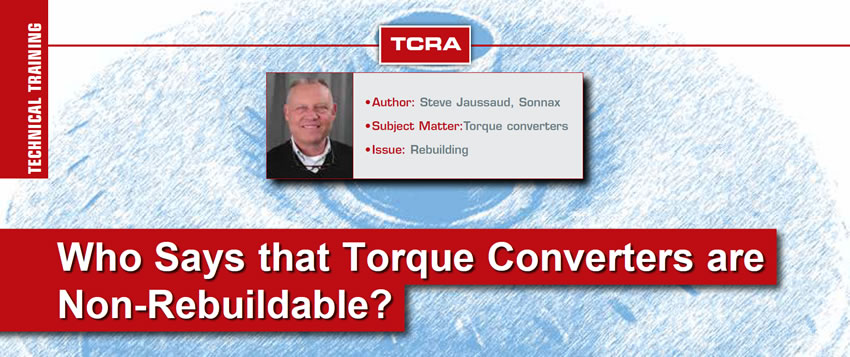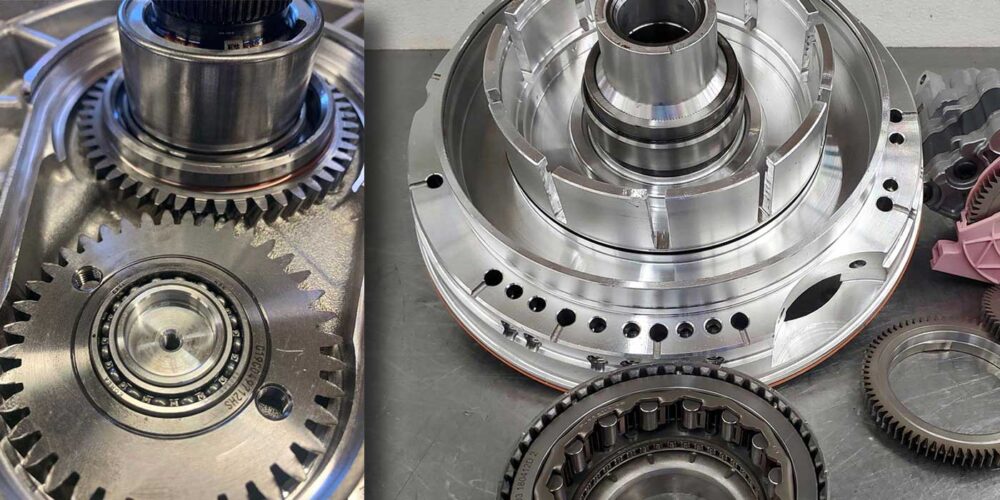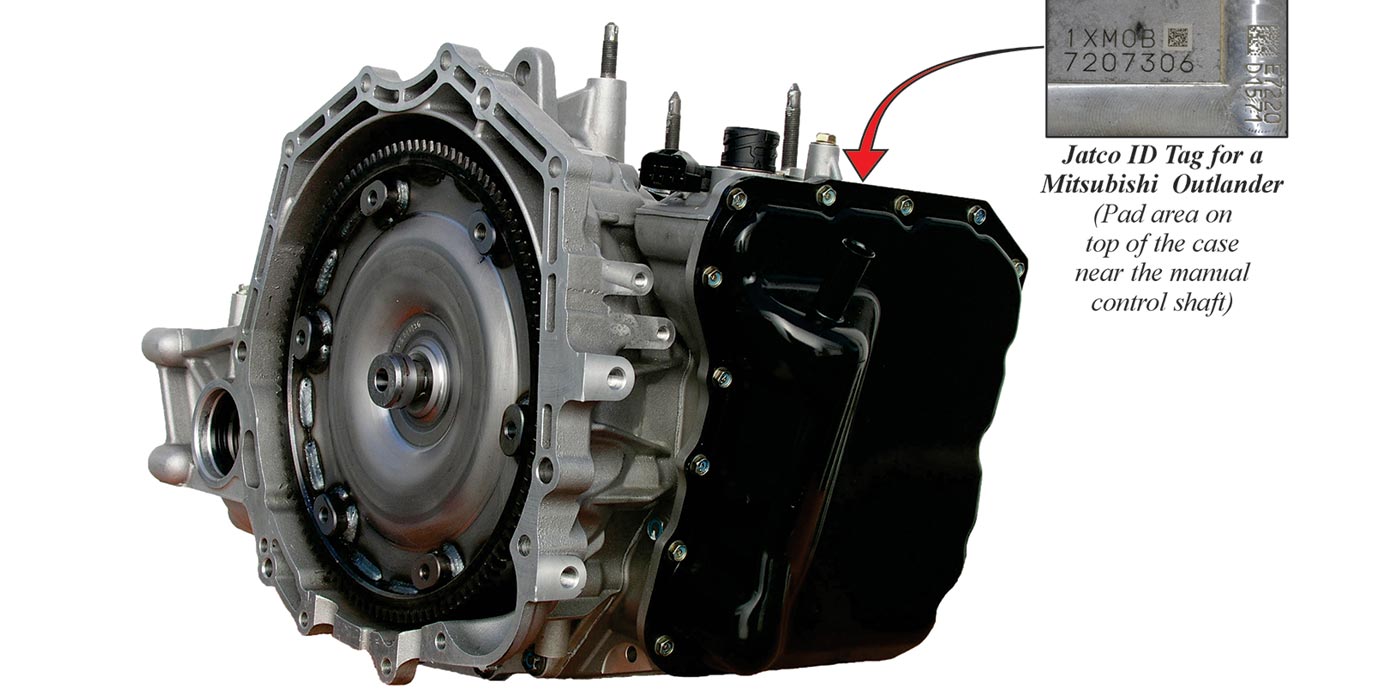
Technical Training
- Author: Steve Jaussaud, Sonnax
- Subject Matter: Torque converters
- Issue: Rebuilding
Who says that torque converters are non-rebuildable? Well, the OEMs have been saying it since the first sealed torque converter rolled off the assembly line, and they continue to say it today. “But,” you say, “I think the torque converter aftermarket gets good support from the OEs, don’t they?”
Well, see what happens when you go the dealership parts-counter and ask for some torque converter parts. But we all know that the torque converter aftermarket has proven the OEMs wrong since they first welded a converter, and as product cycles grow shorter and business gets tougher, we need to make sure that both rebuilders and component suppliers keep our lines of communication open. Knowing early on in the life cycle of a unit what components rebuilders will need is a huge advantage keeping all of our businesses running strong.
When a transmission technician needs parts for a new transmission he has in his shop for the first or second time; he might contact a Major distributor just to see what they know about it and what they have to offer. If it’s really new, or it’s a relatively rare trans type, chances are that the distributor only has a few service items in stock: a seal and gasket kit, a few clutch plates, a filter and maybe a few other items. If that trans tech needs additional parts or information, he can contact the dealership and look online at the exploded view of the transmission to identify and order components. The OEMs also support the transmission repair aftermarket with service manuals that describe diagnostic and disassembly/reassembly procedures on individual units, as well as provide a full complement of specifications, tolerances and clearances.
The wide, wide world of torque converter rebuilding is a whole different ballgame. When a torque converter technician is dealing with a new torque converter, right out of the gate he is at a disadvantage when compared to his transmission technician counterpart. Because the OEMs view the torque converter as a non-serviceable assembly, they do not offer any exploded views, assembly tips, specifications, or (as hinted at above) component parts.
The only thing the dealer can typically offer is a complete converter.

A converter shop with a new unit on the bench can talk to (read: commiserate with) his buddies in other shops and swap valuable information, and he can rummage through his core pile. Of course, if he is a TCRA member, he can log in at TCRAONLINE.COM and see if there is anything there for his unit in question, and he can also use the membership as a sounding board. His next move is typically a stop at a component supplier’s website, companies like Tri Component, Transmission Specialties or Sonnax (full disclosure: the author of this article is a Sonnax employee), there, he can find out if the aftermarket has anything that will help him out with this unfamiliar unit.
This is the critical point where we, as the converter rebuilding industry, need to make sure we have clear and open lines of communication between component suppliers and rebuilders. Rebuilders need to make sure they tell their suppliers what’s failing and what they need, because converter builders don’t have the luxury of ordering components from an OEM dealer network or having any OE support when it comes to published procedures, tools or specifications. Nor should rebuilders expect that component suppliers have a particular part under development. I think I speak for all converter component suppliers when I say that we don’t know what the industry needs or wants unless rebuilders tell us.
For the suppliers, we need to do a better job of anticipating, listening and delivering. On the supplier side, it’s extra critical for us to understand the needs of the industry quickly. Unlike an OE supplier that has the volume of a particular part to warrant, for example, an expensive stamping tool, aftermarket suppliers are challenged in a variety of ways. Once the suppliers see the need, we have several things to figure out. HOW will we make the part in volumes WAY LOWER than the OE makes them, and still make them affordable? For example, the OE can stamp something out in volumes of 200,000-300,000 pieces or more, while the aftermarket might have a total lifetime need of 10,000-15,000 (or less) replacement parts over a 15-year life cycle. No matter how you slice it, there isn’t going to be enough money in the replacement part to tool up the way the OE did. Suppliers may have to make something from solid bar or a forging (there’s that tooling expense again…) in order to meet the needs of the rebuilder. Replacement components must be good quality and priced right, or they are of no use.
Suppliers also struggle with lead times. It’s a challenge to be quick to market when there may be tooling involved, volumes are hard to predict, and drawings and specifications have to be developed from scratch. Remember, unlike the transmission side of the aftermarket, there are no published specs or tolerances available to the aftermarket, but we all know that until a good supply of needed components is available; both rebuilders and suppliers are losing unknown (but surely significant) sales on what can be lucrative units. Another byproduct of lack of components is that core prices go up – it’s a simple case of supply and demand. It’s a fact that speed to market from the suppliers needs to improve.
I am really proud to be part of an industry that hasn’t listened to the OEs when they say that “it’s a non-serviceable assembly.” I like to imagine what the reaction from the torque converter industry pioneers might have been when they first heard that the new, sealed torque converters were not rebuildable. “Bulls..t!” I am sure someone proclaimed, “Hold my beer and watch me while I rebuild this thing!”
Let’s see if we can do a better job of working together to make those guys proud. I know that I am going to try.














